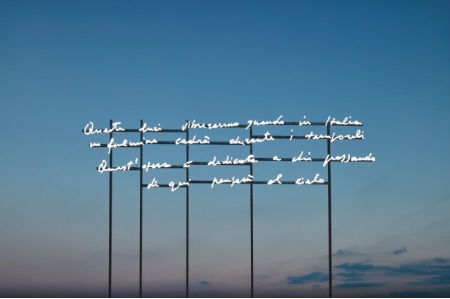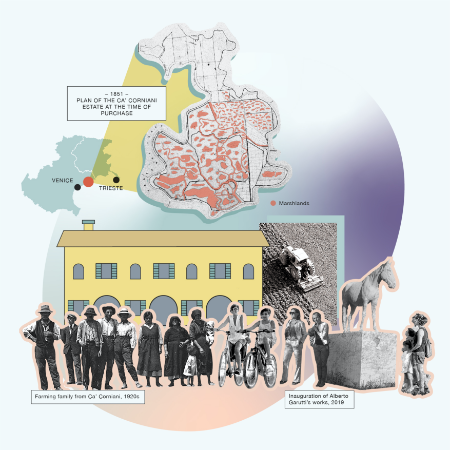A trip to Italy: a young woman discovers Ca’ Corniani

As you know, I’m on holiday in Italy with my family.
After staying in Rome, Florence, Verona, and Venice, yesterday we took a relaxing day for a bike ride in the Venetian countryside.
At home in the Netherlands, we basically only use bikes so after two weeks we were all suffering from withdrawal.
We drove to a colourful, modern, and attractive chequered building in the middle of the countryside, then took the bikes and set off towards Ca’ Corniani.
The route was beautiful: a cycle path ran between fields and flowers, which I discovered were planted by the company that owns the estate, to promote a natural habitat for bees.
I don’t know how my father knew about this place but he always comes up with surprises when we are travelling.
Ca’ Corniani is an old agricultural estate dating back to the mid-1800s. It was a marshy area that had been reclaimed by an Italian insurance company called Generali.
It was a totally innovative operation for the period, given that no one had ever done anything like this before.
A muddy area became a place where the land was cultivated and livestock were raised.
Today everything has changed: the farm continues to exist, but this place has also become a place of tourism and art.
In fact, works of art by the artist Alberto Garutti have been placed at the three entrances to the estate.
One is a large stone farmhouse where farmers and their families once lived, now abandoned, and on which he has built an entirely golden roof.
The second, on the other hand, is a series of statues of animals: dogs and horses that lived in this place, perceived by the artist as its real witnesses.
The last one, my favourite, which I posted the photo of here, is LED writing that lights up whenever lightning strikes somewhere in Italy, and it says: “These lights will vibrate when lightning strikes in Italy during thunderstorms. This work is dedicated to those who, when passing this way, will think of the sky”. 😍
But the most interesting thing happened when we entered the village.
Today, few people live there but in the middle of the last century there were over 3,000 residents who made up a real community between the village and the over 80 tenant farms scattered throughout the countryside. The village was super-modern for the period: it had a school for children, a doctor and a health service available to everyone, training courses, and even a recreation centre.
As we roamed around this incredible place in the July heat, I wondered what life here might have been like 50 or 60 years ago. The answer came from Mrs Zecchin, an old lady who was sitting in her garden enjoying some fresh air. Using the few words of Italian that he knows, my father started asking her questions, as he always does.
She told us that she is 88 and has lived here since she was born. That she lived outside of the village and used to come here from the countryside with her dad once a week, in the ox cart.
Then he would go into the office of the “parón” and she stayed with his wife who gave her biscuits and sweets.
She told us that there was a very strong sense of community among people.
“Families were large; there were 35 of us in my family. There was friendship and everyone knew everyone else. Friendship was important, we helped each other. For example, my uncle was ill for 15 years,” she explained, “and everyone contributed to helping him and the family.”
She likes Garutti’s works of art, saying it pleases her when people pass by and ask her to talk about them.
She’s very happy to live here, in fact when we said goodbye, she told us that she likes it so much that “I will be sorry to die and leave Ca’ Corniani”.
On our way out of the estate, we passed the writing lit up by the lightning once again and it occurred to me that the work is dedicated not only to those who, when passing this way, will think of the sky, but also to those who, by living here, have taken care of this land and the people who inhabited it. 🙏🏻
#travel #cacorniani #country #art #culture #albertogarutti #italy
HISTORY

Between 1851 and 1917, the company engaged in pioneering reclamation work, both territorial and constructional, in the region of Caorle and San Stino, on the north-western border of the great Adriatic lagoon, between the Livenza and Tagliamento rivers. First of all, the banks of the river Livenza were constructed along with a system of ditches and canals to expel water by means of a pump; then the doctor’s house was built, with an adjoining surgery for visits, followed by the nursery, school, post office, church and rectory, and accommodation for the families of tenant farmers and farm workers. A new community was created.
The radical reclamation work - the first of its kind to be carried out in Italy by private individuals and well in advance of state policy in this sector - enabled the creation of new jobs and the first of the company’s farms, which many years later would bring together the Italian agricultural sector of the Generali Group in a single company called Genagricola.
Ca’ Corniani developed one of the first examples of corporate welfare: the residents of the estate were offered a job, health service, training courses, schools for children, a seaside holiday camp, and even a recreation centre where they could meet up. An avant-garde vision of farming activity based on a model of sustainable development.
